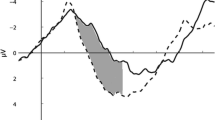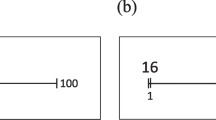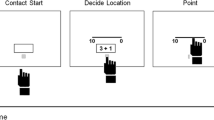Abstract
A spatial representation of number magnitude, aka the mental number line, is considered one of the basic numerical representations. One way to assess it is number line estimation (e.g., positioning 43 on a number line ranging from 0 to 100). Recently, a new unbounded version of the number line estimation task was suggested: without labeled endpoints but a predefined unit, which was argued to provide a purer measure of spatial numerical representations. To further investigate the processes determining estimation performance in the unbounded number line task, we used an adapted version with variable units other than 1 to evaluate influences of (i) the size of a given unit and (ii) multiples of the units as target numbers on participants’ estimation pattern. We observed that estimations got faster and more accurate with increasing unit sizes. On the other hand, multiples of a predefined unit were estimated faster, but not more accurately than non-multiples. These results indicate an influence of multiplication fact knowledge on spatial numerical processing.



Similar content being viewed by others
Notes
Please note that the results did not change substantially when using the absolute estimation error in pixels (instead of the relative measure of units) as the dependent variable.
Please note that the constant working window of about 10 we observed was not driven by the fact that 10 was the largest unit in the experiment. As recommended by Marc Brysbaert we conducted a control experiment in which 46 participants performed an unbounded number line estimation task with units 7 and 13 in a paper–pencil version of the task. Importantly, statistical evaluation of the resulting working windows indicated that it did not differ between unit size 7 and 13 [9.41 vs. 9.76, respectively, t(45) = 1.07, p = 0.32)] as well as from the mean working window over all unit sizes observed in the main experiment [unit size 7: t(45) = 0.43, p = 0.67; unit size 13: t(45) = 0.84, p = 0.41].
References
Ashcraft, M. H., & Moore, A. M. (2012). Cognitive processes of numerical estimation in children. Journal of Experimental Child Psychology, 111, 246–267.
Barth, H. C., & Paladino, A. M. (2011). The development of numerical estimation: evidence against a representational shift. Developmental Science, 14, 125–135.
Berteletti, I., Lucangeli, D., Piazza, M., Dehaene, S., & Zorzi, M. (2010). Numerical estimation in preschoolers. Developmental Psychology, 46, 545–551.
Booth, J. L., & Siegler, R. S. (2006). Developmental and individual differences in pure numerical estimation. Developmental Psychology, 41, 189–201.
Cohen, D. J., & Blanc-Goldhammer, D. (2011). Numerical bias in bounded and unbounded number line tasks. Psychonomic Bulletin and Review, 18, 331–338.
Dehaene, S., & Cohen, L. (1995). Towards an anatomical and functional model of number processing. Mathematical Cognition, 1, 83–120.
Dehaene, S., & Cohen, L. (1997). Cerebral pathways for calculation: double dissociation between rote verbal and quantitative knowledge of arithmetic. Cortex, 33, 219–250.
Dehaene, S., Piazza, M., Pinel, P., & Cohen, L. (2003). Three parietal circuits for number processing. Cognitive Neuropsychology, 20, 487–506.
Ebersbach, M., Luwel, K., Frick, A., Onghena, P., & Verschaffel, L. (2008). The relationship between the shape of the mental number line and familiarity with numbers in 5- to 9-year old children: evidence for a segmented linear model. Journal of Experimental Child Psychology, 99, 1–17.
Fuson, K. (1988). Children’s counting and concepts of cumber. New York: Springer.
Gallistel, C. R., & Gelman, R. (1992). Preverbal and verbal counting and computation. Cognition, 44, 43–74.
Helmreich, I., Zuber, J., Pixner, S., Kaufmann, L., Nuerk, H.-C., & Moeller, K. (2011). Language effects on children’s mental number line: how cross-cultural differences in number word systems affect spatial mappings of numbers in a non-verbal task. Journal of Cross-Cultural Psychology, 42, 598–613.
Hollands, J. G., & Dyre, B. P. (2000). Bias in proportion judgments: the cyclical power model. Psychological Review, 107, 500–524.
Lee, K. M., & Kang, S. Y. (2002). Arithmetic operation and working memory: differential suppression in dual tasks. Cognition, 83, B63–B68.
Moeller, K., Fischer, M. H., Nuerk, H.-C., & Willmes, K. (2009a). Eye fixation behaviour in the number bisection task: evidence for temporal specificity. Acta Psychologica, 131, 209–220.
Moeller, K., Klein, E., Fischer, M. H., Nuerk H.-C., & Willmes, K. (2011b). Representation of multiplication facts: evidence for partial verbal coding. Behavioral and Brain Functions, 7:25.
Moeller, K., & Nuerk, H.-C. (2011). Psychophysics of numerical representation: why seemingly logarithmic representations may rather be multi-linear. Zeitschrift für Psychologie/Journal of Psychology, 219, 64–70.
Moeller, K., Pixner, S., Kaufmann, L., & Nuerk, H.-C. (2009b). Children’s early mental number line: logarithmic or rather decomposed linear? Journal of Experimental Child Psychology, 103, 503–515.
Nuerk, H.-C., Geppert, B. E., van Herten, M., & Willmes, K. (2002). On the impact of different number representations in the number bisection task. Cortex, 38, 691–715.
Nuerk, H.-C., Moeller, K., Klein, E., Willmes, K., & Fischer, M. H. (2011). Extending the mental number line: a review of multi-digit number processing. Journal of Psychology, 219, 3–22.
Nuerk, H.-C., Weger, U., & Willmes, K. (2001). Decade breaks in the mental number line? Putting tens and units back into different bins. Cognition, 82, B25–B33.
Opfer, J. E., & Siegler, R. S. (2007). Representational change and children’s numerical estimation. Cognitive Psychology, 55, 169–195.
Price, A. J. (2001). Atomistic and holistic approaches to the early primary mathematics curriculum for addition. In: M. van den Heuvel-Panhuizen (Ed.), Proceedings of the 25th PME International Conference, 4, 73–80.
Rusconi, E., Galfano, G., Speriani, V., & Umiltà, C. (2004). Capacity and contextual constraints on product activation: evidence from task-irrelevant fact retrieval. Quarterly Journal of Experimental Psychology, 57A, 1485–1511.
Siegler, R. S., & Booth, J. L. (2004). Development of numerical estimation in young children. Child Development, 75, 428–444.
Siegler, R. S., & Opfer, J. E. (2003). The development of numerical estimation: evidence for multiple representations of numerical quantity. Psychological Science, 14, 237–243.
Slusser, E., Santiago, R., & Barth, H. (2013). Developmental change in numerical estimation. Journal of Experimental Psychology: General, 142, 193–208.
Spence, I. (1990). Visual psychophysics of simple graphical elements. Journal of Experimental Psychology: Human Perception and Performance, 16, 683–692.
Sullivan, J., Juhasz, B., Slattery, T., & Barth, H. (2011). Adults’ number-line estimation strategies: evidence from eye movements. Psychonomic Bulletin and Review, 18, 557–563.
Wood, G., Nuerk, H.-C., Moeller, K., Geppert, B., Schnitker, R., Weber, J., et al. (2008). All for one but not one for all: how multiple number representations are recruited in one numerical task. Brain Research, 1187, 154–166.
Author information
Authors and Affiliations
Corresponding author
Appendix
Appendix
Unit | 1 | 2 | 3 | 4 | 5 | 6 | 7 | 8 | 9 | 10 |
|---|---|---|---|---|---|---|---|---|---|---|
Tens | 11 | 12 | 12 | 12 | 11 | 12 | 12 | 12 | 13 | 11 |
12 | 13 | 14 | 13 | 13 | 13 | 13 | 13 | 14 | 13 | |
16 | 16 | 16 | 16 | 15 | 14 | 14 | 16 | 15 | 15 | |
18 | 18 | 17 | 17 | 18 | 18 | 18 | 17 | 16 | 18 | |
19 | 19 | 18 | 18 | 19 | 19 | 19 | 18 | 18 | 19 | |
Twenties | 21 | 20 | 20 | 20 | 20 | 21 | 20 | 21 | 21 | 20 |
23 | 21 | 21 | 23 | 22 | 23 | 21 | 23 | 22 | 23 | |
24 | 24 | 25 | 24 | 25 | 24 | 23 | 24 | 23 | 25 | |
26 | 27 | 27 | 26 | 26 | 25 | 28 | 26 | 27 | 26 | |
27 | 28 | 29 | 28 | 28 | 28 | 29 | 27 | 28 | 27 | |
Thirties | 32 | 30 | 30 | 32 | 30 | 30 | 31 | 32 | 31 | 30 |
34 | 34 | 32 | 33 | 34 | 34 | 33 | 33 | 32 | 33 | |
35 | 35 | 36 | 36 | 35 | 36 | 35 | 35 | 36 | 36 | |
36 | 37 | 38 | 37 | 38 | 37 | 38 | 37 | 38 | 38 | |
39 | 39 | 39 | 38 | 39 | 39 | 39 | 39 | 39 | 39 | |
Forties | 41 | 40 | 40 | 40 | 40 | 41 | 41 | 40 | 40 | 40 |
43 | 41 | 42 | 41 | 43 | 42 | 42 | 42 | 42 | 41 | |
45 | 45 | 46 | 44 | 45 | 44 | 44 | 43 | 45 | 44 | |
46 | 48 | 47 | 48 | 46 | 47 | 46 | 48 | 47 | 48 | |
47 | 49 | 48 | 49 | 48 | 48 | 49 | 49 | 48 | 49 |
Rights and permissions
About this article
Cite this article
Reinert, R.M., Huber, S., Nuerk, HC. et al. Multiplication facts and the mental number line: evidence from unbounded number line estimation. Psychological Research 79, 95–103 (2015). https://doi.org/10.1007/s00426-013-0538-0
Received:
Accepted:
Published:
Issue Date:
DOI: https://doi.org/10.1007/s00426-013-0538-0




